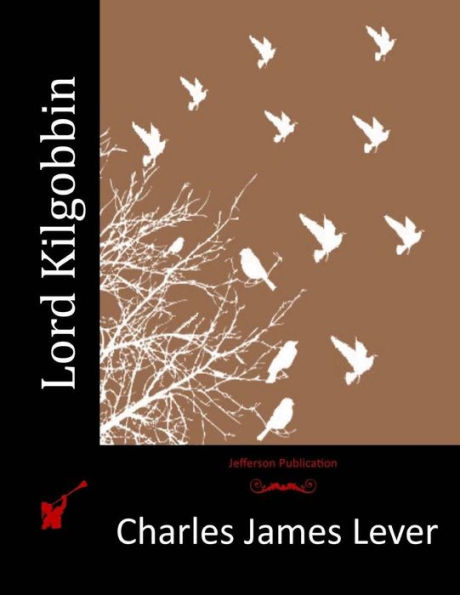Some one has said that almost all that Ireland possesses of picturesque beauty is to be found on, or in the immediate neighbourhood of, the seaboard; and if we except some brief patches of river scenery on the Nore and the Blackwater, and a part of Lough Erne, the assertion is not devoid of truth. The dreary expanse called the Bog of Allen, which occupies a tableland in the centre of the island, stretches away for miles-flat, sad-coloured, and monotonous, fissured in every direction by channels of dark-tinted water, in which the very fish take the same sad colour. This tract is almost without trace of habitation, save where, at distant intervals, utter destitution has raised a mud-hovel, undistinguishable from the hillocks of turf around it.
Fringing this broad waste, little patches of cultivation are to be seen: small potato-gardens, as they are called, or a few roods of oats, green even in the late autumn; but, strangely enough, with nothing to show where the humble tiller of the soil is living, nor, often, any visible road to these isolated spots of culture. Gradually, however-but very gradually-the prospect brightens. Fields with inclosures, and a cabin or two, are to be met with; a solitary tree, generally an ash, will be seen; some rude instrument of husbandry, or an ass-cart, will show that we are emerging from the region of complete destitution and approaching a land of at least struggling civilisation. At last, and by a transition that is not always easy to mark, the scene glides into those rich pasture-lands and well-tilled farms that form the wealth of the midland counties. Gentlemen's seats and waving plantations succeed, and we are in a country of comfort and abundance.
On this border-land between fertility and destitution, and on a tract which had probably once been part of the Bog itself, there stood-there stands still-a short, square tower, battlemented at top, and surmounted with a pointed roof, which seems to grow out of a cluster of farm-buildings, so surrounded is its base by roofs of thatch and slates. Incongruous, vulgar, and ugly in every way, the old keep appears to look down on them-time-worn and battered as it is-as might a reduced gentleman regard the unworthy associates with which an altered fortune had linked him. This is all that remains of Kilgobbin Castle.
1116943522
Fringing this broad waste, little patches of cultivation are to be seen: small potato-gardens, as they are called, or a few roods of oats, green even in the late autumn; but, strangely enough, with nothing to show where the humble tiller of the soil is living, nor, often, any visible road to these isolated spots of culture. Gradually, however-but very gradually-the prospect brightens. Fields with inclosures, and a cabin or two, are to be met with; a solitary tree, generally an ash, will be seen; some rude instrument of husbandry, or an ass-cart, will show that we are emerging from the region of complete destitution and approaching a land of at least struggling civilisation. At last, and by a transition that is not always easy to mark, the scene glides into those rich pasture-lands and well-tilled farms that form the wealth of the midland counties. Gentlemen's seats and waving plantations succeed, and we are in a country of comfort and abundance.
On this border-land between fertility and destitution, and on a tract which had probably once been part of the Bog itself, there stood-there stands still-a short, square tower, battlemented at top, and surmounted with a pointed roof, which seems to grow out of a cluster of farm-buildings, so surrounded is its base by roofs of thatch and slates. Incongruous, vulgar, and ugly in every way, the old keep appears to look down on them-time-worn and battered as it is-as might a reduced gentleman regard the unworthy associates with which an altered fortune had linked him. This is all that remains of Kilgobbin Castle.
Lord Kilgobbin
Some one has said that almost all that Ireland possesses of picturesque beauty is to be found on, or in the immediate neighbourhood of, the seaboard; and if we except some brief patches of river scenery on the Nore and the Blackwater, and a part of Lough Erne, the assertion is not devoid of truth. The dreary expanse called the Bog of Allen, which occupies a tableland in the centre of the island, stretches away for miles-flat, sad-coloured, and monotonous, fissured in every direction by channels of dark-tinted water, in which the very fish take the same sad colour. This tract is almost without trace of habitation, save where, at distant intervals, utter destitution has raised a mud-hovel, undistinguishable from the hillocks of turf around it.
Fringing this broad waste, little patches of cultivation are to be seen: small potato-gardens, as they are called, or a few roods of oats, green even in the late autumn; but, strangely enough, with nothing to show where the humble tiller of the soil is living, nor, often, any visible road to these isolated spots of culture. Gradually, however-but very gradually-the prospect brightens. Fields with inclosures, and a cabin or two, are to be met with; a solitary tree, generally an ash, will be seen; some rude instrument of husbandry, or an ass-cart, will show that we are emerging from the region of complete destitution and approaching a land of at least struggling civilisation. At last, and by a transition that is not always easy to mark, the scene glides into those rich pasture-lands and well-tilled farms that form the wealth of the midland counties. Gentlemen's seats and waving plantations succeed, and we are in a country of comfort and abundance.
On this border-land between fertility and destitution, and on a tract which had probably once been part of the Bog itself, there stood-there stands still-a short, square tower, battlemented at top, and surmounted with a pointed roof, which seems to grow out of a cluster of farm-buildings, so surrounded is its base by roofs of thatch and slates. Incongruous, vulgar, and ugly in every way, the old keep appears to look down on them-time-worn and battered as it is-as might a reduced gentleman regard the unworthy associates with which an altered fortune had linked him. This is all that remains of Kilgobbin Castle.
Fringing this broad waste, little patches of cultivation are to be seen: small potato-gardens, as they are called, or a few roods of oats, green even in the late autumn; but, strangely enough, with nothing to show where the humble tiller of the soil is living, nor, often, any visible road to these isolated spots of culture. Gradually, however-but very gradually-the prospect brightens. Fields with inclosures, and a cabin or two, are to be met with; a solitary tree, generally an ash, will be seen; some rude instrument of husbandry, or an ass-cart, will show that we are emerging from the region of complete destitution and approaching a land of at least struggling civilisation. At last, and by a transition that is not always easy to mark, the scene glides into those rich pasture-lands and well-tilled farms that form the wealth of the midland counties. Gentlemen's seats and waving plantations succeed, and we are in a country of comfort and abundance.
On this border-land between fertility and destitution, and on a tract which had probably once been part of the Bog itself, there stood-there stands still-a short, square tower, battlemented at top, and surmounted with a pointed roof, which seems to grow out of a cluster of farm-buildings, so surrounded is its base by roofs of thatch and slates. Incongruous, vulgar, and ugly in every way, the old keep appears to look down on them-time-worn and battered as it is-as might a reduced gentleman regard the unworthy associates with which an altered fortune had linked him. This is all that remains of Kilgobbin Castle.
9.99
In Stock
5
1

Lord Kilgobbin
230
Lord Kilgobbin
230
9.99
In Stock

Product Details
| ISBN-13: | 9781514692912 |
|---|---|
| Publisher: | CreateSpace Publishing |
| Publication date: | 06/24/2015 |
| Pages: | 230 |
| Product dimensions: | 8.50(w) x 11.00(h) x 0.48(d) |
About the Author
From the B&N Reads Blog
